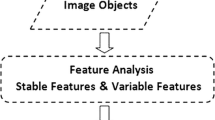Abstract
The processing and analysis of remotely sensed imagery (RSI) is a research hotspot in the information field, and building extraction and change detection are some of the difficult problems. In order to make the maximum use of the effective characteristics and design independently the algorithm of feature extraction, an approach to building extraction and change detection from RSI based on layered architecture containing pixel layer, object layer and configuration layer is proposed. In the pixel layer, the input image is over-segmented and under-segmented, respectively, by a quantity-controllable algorithm using super-pixel segmentation to obtain the segmentation object sets, with which the input image is decomposed into shadow layer, homogeneity layer and edge layer, where the buildings are extracted based on the spatial relationship between the feature areas and segmentation objects. In the object layer, for preserving the accurate contour of the buildings, a new segmentation method based on the traditional graph-cut theory and mathematical morphology is introduced, and then, the buildings extracted from each layer are merged. Finally, in the configuration layer, the change information is detected using spatial relationship of buildings between the old image and the new one. The experimental results reveal that the building contour is extracted accurately, and three types of change including the newly built, the demolished and the reconstructed buildings can be detected; in addition, there is no strict requirement for registration accuracy. For the test images, the overall performance F1 of the building extraction is over 85, and the precision and recall of the change detection are both higher than 90%.









Similar content being viewed by others
References
Achanta R, Shaji A, Smith K, Lucchi A, Fua P, Süsstrunk S (2012) SLIC superpixels compared to state-of-the-art superpixel methods. IEEE Trans Pattern Anal Mach Intell 34:2274–2282
Blaschke T et al (2014) Geographic object-based image analysis—towards a new paradigm. ISPRS J Photogr Rem Sens 87:180–191
Ghanea M, Moallem P, Momeni M (2014) Automatic building extraction in dense urban areas through GeoEye multispectral imagery. Int J Rem Sens 35:5094–5119
Hofman P, Potůčková M, Hofman P, Potůčková M (2017) Comprehensive approach for building outline extraction from LiDAR data with accent to a sparse laser scanning point cloud. Geoinformatics Fce Ctu 16:91–102
Hou B, Wang Y, Liu Q (2016) A saliency guided semi-supervised building change detection method for high resolution remote sensing images. Sensors 16:1377–1400
Huang X, Zhang L (2012) Morphological building/shadow index for building extraction from high-resolution imagery over urban areas. IEEE J Sel Topics Appl Earth Observ Rem Sens 5:161–172
Hussain E, Shan J (2016) Urban building extraction through object-based image classification assisted by digital surface model and zoning map. Int J Image Data Fusion 7:63–82
Janalipour M, Taleai M (2017) Building change detection after earthquake using multi-criteria decision analysis based on extracted information from high spatial resolution satellite images. Int J Rem Sens 38:82–99
Jiménez LI, Plaza J, Plaza A (2017) Efficient implementation of morphological index for building/shadow extraction from remotely sensed images. J Supercomput 73:482–494
Karadağ ÖÖ, Senaras C, Vural FTY (2015) Segmentation fusion for building detection using domain-specific information. IEEE J Sel Topics Appl Earth Observ Remote Sens 8:3305–3315
Kim T, Muller JP (1999) Development of a graph-based approach for building detection. Image Vis Comput 17:3–14
Lagunas E, Amin MG, Ahmad F, Najar M (2013) Pattern matching for building feature extraction. IEEE Geosci Remote Sens Lett 11:2193–2197
Li Z, Liu Z, Shi W (2013) A fast level set algorithm for building roof recognition from high spatial resolution panchromatic images. IEEE Geosci Remote Sens Lett 11:743–747
Liasis G, Stavrou S (2016) Building extraction in satellite images using active contours and colour features. Int J Remote Sens 37:1127–1153
Liu MY, Tuzel O, Ramalingam S, Chellappa R (2011) Entropy rate superpixel segmentation. Comput Vis Pattern Recognit 32:2097–2104
Maltezos E, Doulamis N, Doulamis A, Ioannidis C (2017) Deep convolutional neural networks for building extraction from orthoimages and dense image matching point clouds. J Appl Rem Sens 11:042620-042621-042620-042622
Mayer H (1999) Automatic object extraction from aerial imagery—a survey focusing on buildings. Comput Vis Image Understand 74:138–149
Ok AO (2013) Automated detection of buildings from single VHR multispectral images using shadow information and graph cuts. ISPRS J Photogr Remote Sens 86:21–40
Rai PK, Shrivastava N (2015) Automatic building extraction based on multiresolution segmentation using remote sensing data. Geographia Polonica 88:19-13
Shi J, Malik J (2000) Normalized cuts and image segmentation. IEEE Trans Pattern Anal Mach Intell 22:888–905
Sirmacek B, Unsalan C (2009) Urban-Area and building detection using SIFT keypoints and graph theory. IEEE Trans Geosci Remote Sens 47:1156–1167
Xiao P, Yuan M, Zhang X, Feng X, Guo Y (2017) Cosegmentation for object-based building change detection from high-resolution remotely sensed images. IEEE Trans Geosci Remote Sens 55:1587–1603
Acknowledgements
This work was supported by National Natural Science Foundation of China (Grant No. 41701491), Natural Science Foundation of Fujian Province, China (Grant No. 2017J01464, 2018J01619), Special Funds of the Central Government Guiding Local Science and Technology Development (Grant No.2017L3009) and Program for Changjiang Scholars and Innovative Research Team in University (Grant No. IRT_15R10).
Author information
Authors and Affiliations
Corresponding authors
Additional information
Publisher's Note
Springer Nature remains neutral with regard to jurisdictional claims in published maps and institutional affiliations.
Rights and permissions
About this article
Cite this article
Shi, W., Mao, Z. & Liu, J. Building extraction and change detection from remotely sensed imagery based on layered architecture. Environ Earth Sci 78, 523 (2019). https://doi.org/10.1007/s12665-019-8524-5
Received:
Accepted:
Published:
DOI: https://doi.org/10.1007/s12665-019-8524-5




